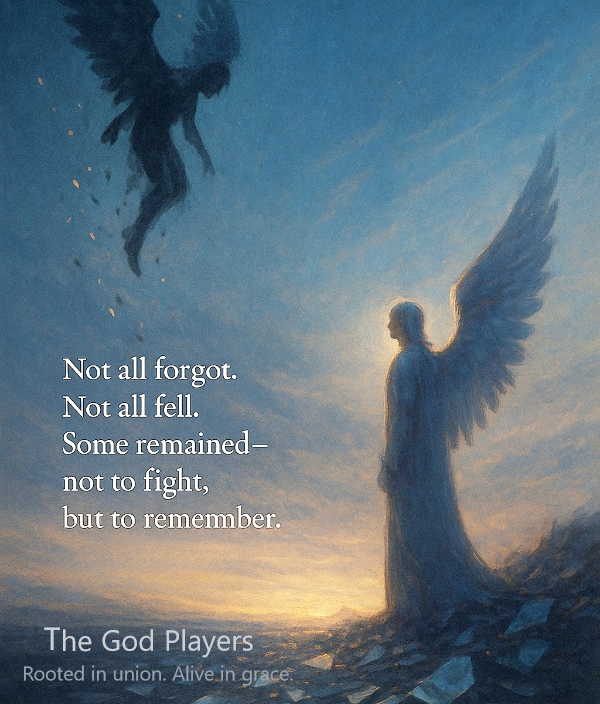It Happened Quietly.
Not with the thunder of a war drum, but with the slow dissonance of something once beautiful slipping out of harmony. And when the light fractured, it wasn’t only Helel who turned. Scripture tells us that some angels left their proper domain (Jude 1:6) and were bound in chains. Peter echoes this in 2 Peter 2:4. Early texts like 1 Enoch describe these beings, often called the Watchers, descending to earth, crossing boundaries, and birthing chaos.
These stories have often been taught as myths, or worse, as fear tactics. But what if they’re echoes of a more profound truth? What if the fall of these others wasn’t just disobedience, but distortion? A twisting of what was beautiful into what could no longer hold the light.
The ancient world was not silent on these matters. Long before theological categories hardened, early voices across cultures spoke of a time when divine beings walked among mortals—not merely as messengers, but as violators of thresholds. The Hebrew scriptures call them bene ha’elohim—sons of God (Genesis 6:1–4). Other traditions speak of shining ones who descended, luminous and powerful, yet dangerously drawn to the daughters of earth.
In Genesis, we are given only a few cryptic verses. But the early Jewish community wrestled with these fragments. Books like 1 Enoch and Jubilees, while not canonized in most modern Bibles, were widely read and respected, even by early Christians. They told the story behind the story: that certain divine beings, known as Watchers, descended in rebellion. Their union with human women brought forth offspring called the Nephilim—giants in the land, beings of unnatural stature and unchecked hunger.
These were not just tall men. They were the product of a broken resonance, where spirit and flesh merged in defiance of divine design. The world groaned under their weight. Violence multiplied. Knowledge was corrupted. And the harmony between heaven and earth disintegrated further.
But the consequences of this crossing didn’t stop with what could be seen. Something more insidious happened: a rupture between realms. When the Nephilim perished, their half-divine spirits did not return to God. They became what the ancient world would later call unclean spirits, roaming the earth, disembodied and restless. These are the spirits Jesus often confronted in the Gospels. The ones who recognized Him before the crowd did.
Disembodied Spirits and Restless Echoes
The Book of Enoch, a text revered by many in the early Jewish and Christian communities, tells of a haunting aftermath: that when the Nephilim—the unnatural offspring of fallen beings and human women—were destroyed, their spirits lingered. No longer bound to body or heaven, these spirits became what later generations would call demons.
Restless. Disembodied. Wandering. Not because they were created for torment, but because they were never meant to exist at all. They dwell in the in-between. Untethered to heaven, yet unclaimed by the earth. They crave embodiment because they were born in broken resonance—half of earth, half of a rebellion in heaven.
While the Book of Enoch is not part of the canonical Bible, it influenced early thought. Church fathers like Tertullian and Irenaeus referred to it, and its themes echo in scripture, especially in Jude and 2 Peter. Its stories are not doctrine, but they may be the scaffolding behind some of what the early church understood and taught.
Jesus Himself encountered these spirits. They knew who He was, recognized his authority, and feared being cast back into the Abyss—the same term echoed in Luke 8:31, where a legion of spirits begs Jesus not to send them there.
The early Church did not imagine demons as horned devils wielding pitchforks. They saw them as lost things—born of forbidden union, lingering outside creation’s harmony. And perhaps the angels still watch them…Grieved by what they once saw fall.
The Angels That Remained
Not all turned. Not all forgot. Some remained faithful to the Light, not clinging to power, but to purpose. These are the ones we call malakim, the messengers, the burning ones, the watchful witnesses of heaven. They did not descend in rebellion. They stayed—not in passivity, but in unwavering allegiance to divine love.
Scripture tells us they minister to those who will inherit salvation (Hebrews 1:14). They are present at moments of birth and death, in wildernesses and upper rooms. And while we often picture them as warriors with flaming swords, perhaps their greatest strength is not in battle, but in clarity.
They remember. They remember what union looks like. They remember the sound of unbroken harmony before it fell out of tune. They are not jealous of humanity. They do not long to be worshipped. They long for us to awaken. To remember. To be restored. They are not gatekeepers of heaven. They are guardians of the memory. And perhaps… they are still singing the same song they began before the world was formed—waiting for us to join in again.
What the Angels See Now
They see a world still wrapped in shadows, yes, but they also see Christ in us. They see the restoration already unfolding. They know that what was finished at the cross is now being awakened in time. They are not waiting to see who is worthy. They are watching for the remembering.
When you speak light, they rejoice. When you choose union over pride, they draw near. When you rest in grace, they rest beside you. Because they know the ending, and they know it is glorious.
To Be Continued…
In Part Three, we’ll explore how this story of fall and remembrance relates to us personally, not as an abstract cosmic tale, but as a daily invitation to live from the light we were always meant to reflect.


